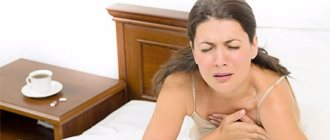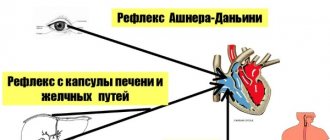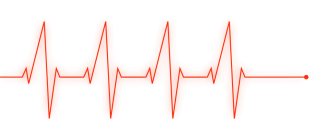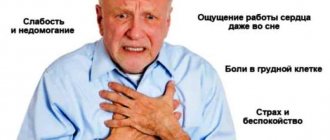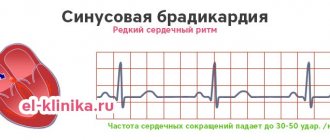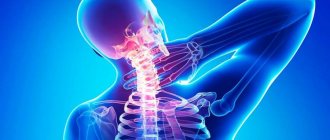Tachycardia is a pathology in which the number of heart contractions (HR) increases relative to the norm - 60-80 beats per minute.
An attack of tachycardia can be a completely physiological phenomenon, for example, after active physical exertion. In this case, it goes away on its own and does not require any intervention, but pathological forms must be treated under medical supervision.
Usually the attack begins suddenly, the contraction of the heart accelerates (up to 120-150 beats per minute), weakness, stabbing pain in the heart, and a feeling of fear may occur. Provoking factors can be stress, large meals, drinking alcohol or caffeine, an allergic reaction, bloating, hot flashes during menopause in women.
How to stop an attack of tachycardia
Special exercises and techniques can help stop an attack of tachycardia at its first signs.
- Take a deep breath and hold your breath, while trying to push the air down.
- Breathe deeply for 5-10 minutes: take a deep breath and exhale slowly (3 times longer).
- Press your fingers firmly on your eyeballs (until it hurts) for 10 seconds, then release. Continue this action for several minutes.
- Fill a basin with ice water and immerse your face in it for a few seconds. You can simply wash your face with cold water. The temperature change should cause your heart rate to drop.
- Sometimes a strong cough or artificially induced vomiting helps stop the attack.
If the condition does not improve and the pulse exceeds 120 beats per minute, immediately seek medical help.
Tachycardia with endocrine disorders
Some disturbances in the functioning of the endocrine system directly affect the functioning of the heart. Sinus tachycardia occurs under the influence of excess amounts of thyroid hormones during thyrotoxicosis. In addition to palpitations, this disease is characterized by
- feeling of heat,
- elevated body temperature,
- excitability and frequent mood swings,
- insomnia,
- weight loss with increased appetite,
- menstrual irregularities in women,
- change in facial expression (it takes on an angry look).
Much less common are tumors of the adrenal glands, which intensively synthesize adrenaline. Rapid heartbeat is observed with pheochromacytoma. In addition to tachycardia, this disease manifests itself with a sharp increase in blood pressure, feelings of fear, anxiety, chills, headaches, pain in the heart, nausea, sweating and a feeling of thirst. Often these symptoms occur simultaneously, so the condition can be described as an attack. If these signs occur along with tachycardia, you should contact an endocrinologist.
Breathing exercises for tachycardia
It is often easier to prevent tachycardia than to deal with attacks. And special breathing exercises can help you in this matter. It improves the filling of the heart with blood, trains the heart muscle, saturates the blood with oxygen, enhances gas exchange and stabilizes the pulse. In addition, it relieves emotional stress and calms the nervous system. Many methods of correct breathing for tachycardia have been developed, but the most popular and effective gymnastics are Buteyko, Strelnikova and qigong.
Breathing exercises according to Buteyko
These exercises, which help the heart, are known all over the world and are practiced by people in many countries. Initially, the complex was developed for patients with asthma, but later its creator realized that it could also be effective for people suffering from tachycardia. It is based on diaphragm training, and the complex itself consists of seven exercises.
- Inhale through your nose (for 5 seconds), leaving your stomach at rest, stop breathing for a few seconds and exhale. Perform 10 approaches.
- Inhale for 9 seconds, filling the diaphragm with air first and then the chest. Exhale slowly, rest for a few seconds. Take 11 similar breaths.
- Massage the bridge of your nose during rest breaks.
- Breathe alternately through your left and right nostrils (close one with your finger). Take 10 breaths into each nostril.
- Take one deep breath, while drawing in your stomach and hold your breath for 8 seconds.
- Take 12 breaths over the course of a minute (each should last at least two seconds).
- Normalize your breathing.
This breathing exercise has some contraindications: age under four years, developmental delay or mental retardation, period of viral diseases, severe bleeding or chronic tonsillitis. In these conditions, exercise can make you feel worse.
Complex of breathing exercises according to Strelnikova
These breathing exercises for tachycardia help fill the blood with oxygen. They should be performed twice a day (ideally before breakfast and before bed) for 25-30 minutes. In this case, you can gradually increase the load every day. Strelnikova’s gymnastics is also called paradoxical, because breaths in it are always combined with any movements that complicate this phase of breathing. The technique involves a short and noisy inhalation through the nose and a calm, smooth, voluntary exhalation (through the mouth or nose). It is important not to take in too much air when inhaling and not to interfere with exhalation; let all the air come out completely.
At first, you can take 4 breaths, and then double them, gradually reaching 32 breaths in a row.
The complex includes a large number of breathing exercises; we will give only a few of the main ones.
- In a standing position, bend your elbows and place them in front of you (as if for a game of “Ladushki”), then take a short and noisy breath in through your nose and at the same time clench your hands into fists (only the palms move, the hands are motionless). Exhale smoothly and calmly, while unclenching your fists. For the first time, take 8 breaths, then you can gradually increase their number.
- While standing, take a few small breaths and then start walking (1 breath per step). For the first time, take 8 breaths, then you can increase their number.
- In a standing position, lower your arms down and clench your fists for each inhalation, and unclench them for each exhalation. Repeat 6 times with a 25 second rest.
- In a standing position, keep your hands on your belt, while inhaling, lower your hands down, strongly unclenching your fingers, and as you exhale, return them to their previous position. Perform 12 times with a rest of 5-7 seconds.
- Place your feet shoulder-width apart, while inhaling, bend over and place your arms to the sides, and as you exhale, return to the starting position. Repeat 12-13 times with short rest breaks.
- Tilt your head left and right, take a sharp breath at the end point of the tilt.
- Perform springy bends of the torso forward and at the same time take a sharp, noisy breath at the lowest point. It is not necessary to bend very low and straighten your back completely.
- Bend your arms at the elbows and raise them to shoulder level. Bring your arms together in front of your chest (at this moment the upper part of your lungs is compressed) and take a noisy, active breath at this moment.
- Stay in the starting position, perform springy bends back and bring your arms in front of your chest. Inhale at the extreme point of the inclination.
- Perform spring squats in a half-lunge (one leg in front, the other behind) and bring your arms down. Inhale at the extreme point of the squat at the moment when you bring your arms together.
- Bend forward and backward like a pendulum. Inhale at the extreme point of the tilt; when bending back, bring your arms together in front of your chest.
Contraindications to performing this complex are: myopia, glaucoma, high blood pressure. Also, you should not combine Strelnikova’s exercises with other breathing techniques.
A set of qigong exercises
For arrhythmia and tachycardia of the heart, Tibetan qigong gymnastics is also effective. It is performed 2 hours after eating. It is important to monitor your pulse so that it does not exceed 120 beats per minute. If you experience shortness of breath or pain in the heart area during exercise, stop exercising and consult your doctor.
- Place your feet shoulder-width apart and lower your arms down. Wiggle your arms, then bend them at the elbows, lift them up and throw them down sharply. Relax and rest for a few minutes.
- Standing in one place, raise your legs one at a time. As you lift your leg, throw your opposite arm up. This exercise usually results in intense sweating.
- Standing straight, spread your arms to the sides and raise them with your palms up. Bending your back a little, take a slow breath, lean forward and, lowering your clenched fists, exhale.
- Standing straight, raise your arms at chest level and bend them slightly at the elbows (fingers should point up). As you inhale, smoothly spread your arms out to the sides as far as possible, squeezing your chest forward. As you exhale, return to the starting position. Continue the exercise until a feeling of warmth appears in your chest; it normalizes the functioning of the heart very well.
- Place your feet shoulder-width apart, raise your arms to chest level and connect them together. Make small circular movements with your hands; it is important to inhale and exhale in one circle.
- Standing straight, clasp your hands together and raise them to chest level. As you inhale, raise one elbow and lower the other. As you exhale, smoothly change your elbows, slightly bending your spine. Exercise stimulates the functioning of the heart and lungs well.
In general, any breathing exercise helps not only the heart, it relaxes the entire body, improves blood circulation, fills the blood with oxygen and relieves nervous tension well.
How to treat tachycardia in the hospital and at home?
Tachycardia is considered a general concept in the practice of a cardiologist, which combines any disturbance of heart rhythm, accompanied by an increase in the number of contractions of the atria or ventricles. Due to the fact that this is a fairly large group of diseases, approaches to eliminating this pathological condition also vary significantly. Tachycardia can be treated independently or with the help of a doctor. In the latter case, there is the possibility of drug treatment or surgical intervention.
Drug groups
- beta blockers, which help slow down the conduction of the excitatory signal through the heart and are effective for all types of tachycardia;
- calcium channel blockers reduce the concentration of this ion inside striated muscle cells, which reduces the frequency and strength of contractions during tachycardia;
- sodium blockers affect the action potential and are also effective for arrhythmia;
- Cordarone is placed in a separate group, but this drug is rarely used for tachycardia, mainly in its ventricular form.
Medicines for tachycardia include not only antiarrhythmics.
Drugs with a different mechanism of action that are used in the treatment of patients with high heart rate include:
- Sedatives that reduce the excitability of the sympathetic nervous system, thereby eliminating its increased effect on the conduction system of the heart. These drugs are especially effective in patients with vegetative-vascular dystonia, panic attacks and other mental disorders. It is advisable to take them after meals.
- Metabolic drugs that improve the nutrition of myocardial cells and nerve fibers of the cardiac conduction system. These include Mildronate, Mexicor, Preductal and some others. These drugs are practically harmless and have no contraindications. They are prescribed in tablets for oral administration after meals.
- Asparkam (magnerot) is a medicine that contains potassium and magnesium salts. As a result of their intake after meals, the level of these electrolytes in the muscle cells of the heart, as well as in the intercellular space, is normalized.
In addition to specific therapy, in the treatment of rapid pulse (especially of sinus origin), medications for tachycardia that do not have a direct effect on the heart can be used. In this case, these drugs affect the cause of the disease. For example, for anemia, iron supplements are used, for thyrotoxicosis - Mercazolil, etc. Take them after meals.
It is important to remember that for tachycardia, treatment should be selected strictly individually, since the sensitivity of patients to one drug can be completely different.
Surgical operations
Surgery for cardiac arrhythmia cannot be performed after eating, since various complications can occur during anesthesia, including aspiration pneumonia. Since most operations are performed as planned, the patient is not recommended to eat in the evening.
Radical methods for treating arrhythmia and tachycardia include:
- catheter ablation;
- valve replacement;
- installation of a pacemaker
- stenting or bypass surgery of the coronary arteries;
- implantation of a cardioverter-defibrillator;
- removal of hormone-producing tumors;
- heart transplant.
All of these interventions for arrhythmia are aimed at eliminating the source of tachycardia. After normal myocardial function is restored, the rhythm disturbance also disappears.
Home therapy
Treatment of tachycardia at home can be done with herbs, exercises, diet, and various techniques that slow down the conduction of nerve impulses in the heart. Medication treatment at home is also possible, but it must be agreed with your doctor.
Uncontrolled use of antiarrhythmic drugs can cause the development of life-threatening cardiac arrhythmias and even death of the patient.
Phytotherapy
Herbal treatment at home is perhaps the most common and quite effective method of treatment for arrhythmia and rapid pulse.
The following drugs are effective for treating tachycardia:
- You can reduce your heart rate during arrhythmia by taking turnip decoction. To do this, pour 200 ml of liquid into two large spoons of chopped root vegetables and cook for 15 minutes. Then strain and drink after meals.
- For uneven pulse and tachycardia, you can prepare a decoction of peppermint. To do this, brew a small spoonful of dried leaves of the plant with boiling water. You can also drink this medicine instead of regular tea after meals.
Physical training
A simple set of exercises aimed at strengthening the muscles of the body and heart can be performed by almost every patient. This does not require special equipment, and gymnastics can be done at home. Physical exercise should not be done after meals, since with a full stomach these activities do more harm than good. The optimal time for gymnastics is early morning.
Diet
The diet is not only possible, but also must be followed at home.
If arrhythmia and increased heart rate occur in a patient after eating, then most likely the mechanism of its development is associated with irritation of the diaphragm by a full stomach. In this case, a diet in which food is taken frequently, but in small portions, will help cope with tachycardia. This will reduce the load on the heart, and the patient’s condition will improve significantly.
The same can be said about overweight people. They have a relationship between body weight and the load on the myocardium. In this case, by reducing excess weight, the patient will reduce not only the load on the heart, but also the risk of developing arrhythmia. Any low-calorie diet will do to achieve this.
The cause of a rapid pulse may be a lack of certain vitamins and other nutrients, so nutrition for such arrhythmias should be balanced.

